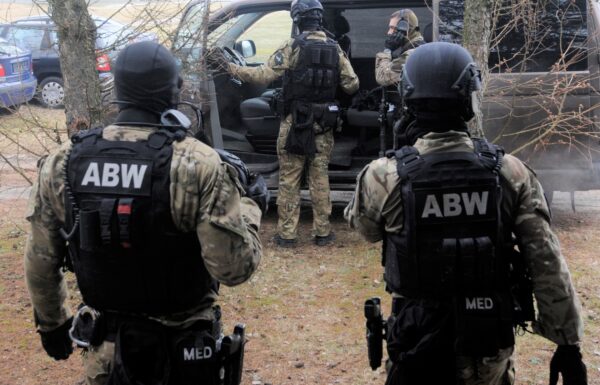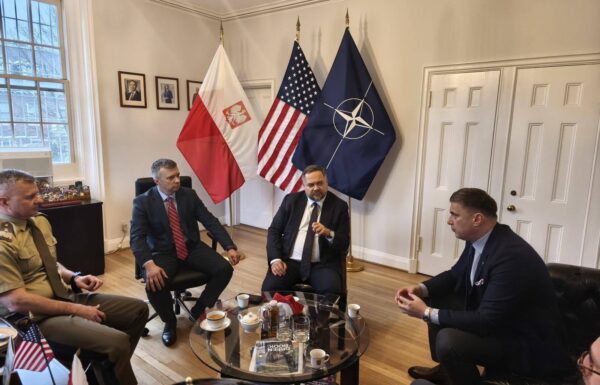According to the Defense Security Cooperation Agency (DSCA) under the contract for sale of thirty two F-35 fighter jets Poland will also acquire: thirty-three Pratt & Whitney F-135 Engines, Electronic Warfare Systems, Command, Control, Communications, Computer and Intelligence/Communications, Navigation and Identification (C4I/CNI), Autonomic Logistics Global Support System (ALGS), Autonomic Logistics Information System (ALIS), Full Mission Trainer, Weapons Employment Capability and other Subsystems, Features, and Capabilities, F-35 unique infrared flares, reprogramming center, F-35 Performance Based Logistics, software development/integration, aircraft ferry and tanker support.
The sale will also include: support equipment, tools and test equipment, communications equipment, spares and repair parts, personnel training and training equipment, publications and technical documents, U.S. Government and contractor engineering, logistics, and personnel services, and other related elements of logistics and program support.
The future contract will be finalized under the FMS procedure, which means that the U.S. government will partake in the transaction. Furthermore, new fighter jets and auxiliary equipment will be delivered to Poland in partnership with U.S. Armed Forces, which will also assist in the training of the first batch of Polish pilots and maintenance personnel.
The future of Polish Air Force
The intention of the Polish MoD is to increase the number of F-35s in the Air Force’s inventory to 48, which would make up for the same number of currently operated F-16C/D Block 52+ jets / Picture: Tech. Sgt. Matthew Plew, USAF
The future Polish 5th generation fighter jets will be procured under the Harpia programme, which was re-prioritized and initiated by the Polish Ministry of Defence (MoD) late last year. Originally, the ministry intended to launch an open, international tender, which would allow for a number of Western manufacturers to submit their offers and present the advantages of many fixed-wing combat platforms, which are available on the market.
This process would help the Polish authorities to consider and evaluate a number of sales opportunities and select the ones, which in the best way meet the requirements of the Polish Air Force. Furthermore, the open tender procedure could also fuel the competition among bidding companies and force them do modify their offers in order to attract the Polish authorities, e.g. by lowering the acquisition cost.
However, in the beginning of 2019 the Polish MoD has publicly announced its intention to procure the U.S.-manufactured F-35 fighter jets in the Conventional Take Off and Landing configuration, ceasing the tender procedure, which most likely had not even fully commenced yet by that time. Furthermore, on 28th of May, Mariusz Blaszczak, the head of the Polish MoD, announced via social media that his department had already sent a Letter of Request (LoR) to DSCA in this regard.
‘I treat this assignment as a priority. I care about replacing the Soviet-era equipment in the Polish Air Force with a more modern one’ said Mariusz Blaszczak.
In early 2019 Wojciech Skurkiewicz, the Secretary of State at the Polish MoD, suggested that the first batch of sixteen F-35 fighters could enter service in the Polish Air Force by 2026. Another batch, comprising of the same number of aircraft, should be acquired at the latter date, most likely by 2035.
It is also expected that the fleet of Polish 5th generation fighter jets will eventually increase, as the MoD has already suggested that it might acquire another batch of these aircraft in the future. According to Skurkiewicz the department intends to bring the total number of Polish F-35s to 48, which would complement the same number of F-16C/D Block 52+ jets, that are currently operated by the Polish Air Force.
Modernization underway
The Harpia programme is intended to speed up the technical modernization of Polish Air Force’s combat fleet. Acquisition of new, 5th generation fighter jets will allow to commence the gradual phase out of currently operated, legacy platforms, such as the Su-22 bombers/fighters and MiG-29 fighters. Due to worsening technical condition and obsolescence of their onboard equipment, these aircraft no longer meet the requirements of the modern battlefield.
Furthermore, a growing number of accidents, which had occurred during the last couple of years and resulted in the loss of several of MiG-29 fighters, led the Polish MoD to the conclusion, that further usage of Soviet-era aircraft is pointless and could only lead to a gradual decrease of Polish Air Force’s operational capability.
Although the acquisition of the 5th generation fighters seems to be on the fast track, it still will require a significant part of the time, until new Polish combat aircraft reach the final operational capability. In the meantime, the Polish airspace will most likely be protected by only a fleet of 48 F-16s, as further use of Su-22s or MiG-29s seems pointless, because they require constant overhaul and repairs and do not provide requires operational efficiency.
Acquisition programmes hampered
Acquisition of 5th generation multirole fighters will significantly improve the operational capabilities of the Polish Air Force, making it able to better commit to the security of Poland and NATO and meet the requirements of the modern battlefield / Picture: MON
Although the final value of the contract for the acquisition of F-35s will most likely by scaled-down during future negotiations, the cost of this programme will still have a significant effect on MoD’s budget and could jeopardize a number of other Polish modernization programmes. Especially if the decision will be taken to finance the F-35 procurement through the MoD’s own budget and not a separate, government-level allocation.
On top of projects, which might get hampered, stopped or even cancelled, is the 2nd phase of the Wisla medium range air-and-missile defence programme, that calls for the procurement of another six batteries of the Patriot system along with a new 3D radar, CMS and a number of low-cost effectors. Wisla is expected to be supplemented by the Narew short range air defence system. Its acquisition, although being depicted by the MoD as one of priorities, is also considered as uncertain.
The future of the Polish attack helicopter fleet also does not look bright, as the planned procurement of a number of rotary-wing platforms under the Kruk programme has been stalled for years. The same problems are faced by the Polish Navy, which has a requirement for a fleet of modern submarines, frigates and corvettes, that, however, has not yet been met by the MoD.
































